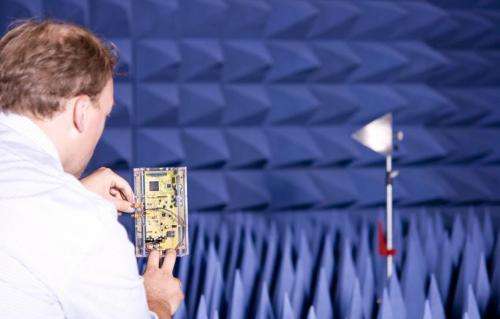Radar measurements of highest precision

Scientists of KIT and Ruhr-Universität Bochum have reached a record precision in radar distance measurements. With the help of a new radar system, an accuracy of one micrometer was achieved in joint measurements. The system is characterized by a high precision and low cost. Potential applications lie in production and plant technology.
Precise determination of distances is of increasing importance in fabrication technology, for instance, when actuating robots, producing micromechanical components, or controlling machine tools. Frequently, glass scales, inductive sensors, or laser measurement systems are used for distance measurements. Glass scales are very precise and reach micrometer precision. However, they are too inflexible and expensive for daily use. Inductive sensors measuring distances with a coil, magnetic field, and movement work in a contact-free manner and, hence, without wear, but are limited in the measurement repetition rate. Lasers also allow for a highly precise measurement, but are not suited for environments with dust, humidity, or strongly changing light conditions. Radar signals, by contrast, can penetrate dust and fog quite well. So far, radar systems have been used mainly for weather observation, air monitoring or distance measurement in vehicles.
Scientists of the Institut für Hochfrequenztechnik und Elektronik (IHE) of Karlsruhe Institute of Technology (KIT) under Prof. Thomas Zwick and of the Chair for Integrated Systems of Ruhr-Universität Bochum (RUB) under Prof. Nils Pohl have now developed and successfully applied a radar system for distance measurements. It is characterized by a so far unreached precision: In a joint test in July this year, the researchers from Karlsruhe and Bochum reached a new record precision for radar distance measurements of one mi-crometer. One micrometer is a millionth of a meter. For comparison: A human hair is about 40 to 60 micrometers thick.
For measurement, the scientists use a frequency-modulated continuous wave radar (FMCW radar), whose emitter is operated continuously during measurement. The RUB researchers developed the hardware, KIT scientists the algorithmics. The radar system with a special measurement setup measures distances of up to several meters in free space with micrometer accuracy. Compared to laser systems, this system is not only cheaper, but can also measure absolute positions. Due to this quasi unlimited range of uniqueness, the radar is far superior to the laser.
The radar system is now being optimized in several research projects. Its accuracy will be further improved. In the future, it will be used to make measurements in production and plant technology with high precision, in a flexible manner, and at low costs.
Provided by Helmholtz Association of German Research Centres

















